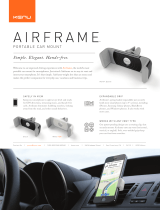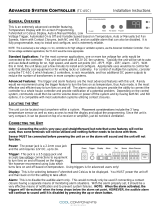Page is loading ...



Thank you for choosing AC Infinity. We are committed to product quality and
friendly customer service. If you have any questions or suggestions, please
don’t hesitate to contact us. Visit www.acinfinity.com and click contact for our
contact information.
WELCOME
EMAIL
support@acinfinity.com
WEB
www.acinfinity.com
LOCATION
Los Angeles, CA
3

MANUAL CODE AF1902X1
UPC-A
819137020153
819137020160
819137020177
819137020184
854759004068
854759004549
854759004372
854759004389
PRODUCT
AIRFRAME T7
AIRFRAME T7
AIRFRAME T7-N
AIRFRAME T7-N
AIRFRAME T9
AIRFRAME T9
AIRFRAME T9-N
AIRFRAME T9-N
MODEL
AC-AFT7-BE
AC-AFT7-WE
AC-AFT7-BN
AC-AFT7-WN
AC-AFT9-BE
AC-AFT9-WE
AC-AFT9-BN
AC-AFT9-WN
4

MANUAL INDEX
Company Contact ............................................................
Manual Index ...................................................................
Closet Cooling Guide .......................................................
Key Features ...................................................................
Product Contents .............................................................
Installation .......................................................................
Filter Maintenance ...........................................................
Connecting Additional Fans .............................................
Controller Programming ..................................................
Other AC Infinity Products ...............................................
Warranty ..........................................................................
Page 3
Page 5
Page 6
Page 7
Page 8
Page 9
Page 15
Page 17
Page 18
Page 24
Page 25
5

CABINET COOLING GUIDE
INTAKE AND EXHAUST
All cabinet fan systems should contain an
intake and an exhaust variable which can
either be fans or ventilation holes. This is
required to balance the static pressures
between the inside and outside room.
FAN POSITIONING
Due to natural convection, warmer air,
which is less dense than colder air, will
rise on its own. It is ideal to position fans
near the top of the room configured to
exhaust out the warmer air and position
fans near the lower part of the room to
push in colder air.
CFM REQUIREMENTS
A fan or set of fan’s CFM rating measures
the rate at which air flows in of a space.
To obtain the required CFM rating, divide
the dimensions of a cabinet by 1728 to get
the cubic feet area then multiply by three
to account for various real world variables.
SIZE OF ROOM
L x W x H (inches)
1728
6

KEY FEATURES
ALUMINIUM FRAME
Features an aluminium frame
with CNC machined corners
and edges to give rooms a
professional appearance.
DUAL BALL BEARINGS
Fans contain long-life ball
bearings rated at 67,000
hours. Also enables fans to
be mounted in any direction.
SMART CONTROLLER
Controller enables temp.
monitoring, thermal control,
speed control, alarms, and
SMART energy mode.
DETACHANLE FILTER
A high density filter helps
remove dust from entering
or exiting the room. Can be
easily detached for cleaning.
FAN EXPANSION PORTS
Each fan unit contains a port
to connect an additional fan
unit to share the same controls
and power source.
7
THERMAL PROBE
The corded sensor probe
constructed of stainless
steel ensures an accurate
temperature reading.
PROBE
POWER
EXT.

PRODUCT CONTENTS
T-SERIES
8
PLASTIC STENCIL (x1) WOOD MOUNTING
SCREW SET (x4)
POWER ADAPTER (x1)
COOLING FAN UNIT (x1) DETACHABLE FILTER (x1)
(May be on Fan Unit)
THERMAL PROBE (x1)

INSTALLATION
STEP 1
Determine where you wish to
mount the cooling fan unit onto
your door or wall. Position the
stencils and apply tape to the
outer edges.
STEP 2
Use a pencil to outline the center
square and four outer screw holes
on the one stencil. Check for
accuracy before proceeding to the
next step.
9

INSTALLATION
STEP 3
Remove the plastic stencil and
tape. If you prefer machine screws
instead of wood screws to mount
the fan and controller, use a power
drill to create four screw holes.
Recommended drill bit size around
16/64”.
STEP 4
Using a saw, cut out the center piece
as outlined by your markings from step
one. You may need to first drill a hole
at each of the corners to fit your saw
through. A power jigsaw may be
preferred for thicker wood.
10

INSTALLATION
STEP 5
Place the fan unit into the newly cut
square so that each screw hole is
properly aligned. Please make sure
that the cut center hole is large
enough that the plastic backside of
the fan does not come into contact
with the cabinet. This is to minimize
vibrations which will can cause noise.
STEP 6
Using the four machine screws, secure
the fan unit’s frame onto the cabinet or
wall. Push each screw through their
corresponding hole located on the frame
and wall. The included wood screws can
also be used instead. Tighten the nuts on
the other side.
11

INSTALLATION
STEP 7
After mounting the fan unit onto a door
or wall, locate the filter piece. If it has
not yet been installed, align and insert
the filter piece into the docking holes
located on the backside of the fan unit.
STEP 8
Push the filter piece against the back
of the fan unit to click it into position.
Please note that using the detachable
filter will reduce air performance of the
cooling fan unit.
12

INSTALLATION
STEP 9
To power the fan unit, locate the
corded wall adapter. Plug the
adapter’s connector into the port
marked “POWER” located on the
backside of the fan unit.
13
STEP 10
Plug the adapter head into a standard
outlet or power strip.and check to see
if the fan's unit screen is on. You may
need to press the leaf button if the unit
was previously set to ECO Mode.

14
INSTALLATION
STEP 11
To set up temperature readings,
locate the corded thermal probe.
Plug the probe’s connector into
the port marked “PROBE” located
on the backside of the fan unit.
STEP 12
After plugging in the probe, check the
fan unit’s screen to see that there is
now a temperature reading. Position
the thermal probe near your devices
with the highest temperatures.

15
FILTER MAINTENANCE
STEP 1
To detach the filter piece, pull
on its lever to release it from
the backside of the fan unit.
The filter should be cleaned
periodically to avoid decreasing
the fan’s airflow performance.
STEP 2
Rinse the filter piece with running
water or wipe it down with a damp
cloth to remove dust and other
particles.

FILTER MAINTENANCE
STEP 3
Wipe down the filter piece thoroughly
with a cloth and leave it out to dry. The
filter piece should be completely dry
before reattaching it to the fan unit.
STEP 4
Lastly, push the filter piece against
the back of the fan unit to put it
back into position.
16

17
FAN EXTENSIONS
S-series fan units connected to the T-series will share the same fan speed and
temperature trigger settings. For example, an AIRFRAME T7 exhaust system
can control an AIRFRAME S7-N system for intake. If the S-series fan contains
an inline speed controller, please make sure their speed is set on high.
CONNECTING MORE FANS
Each T-series fan unit includes a port marked
“EXT.” on its backside that enables it to connect
one S-series fan unit to share the same smart
controls and power source.

PROGRAMMING
18
1. MODE BUTTON
Cycles through the modes:
AUTO, SMART, SPEED,
ALARM, BUFFER. Holding
for three seconds will lock or
unlock the display.
2. UP / DOWN BUTTON
The up and down buttons
changes the setting temp,
alarm temp, display
brightness, or the speed
of the fan.
3. LEAF BUTTON
This turns the display off
while programs run in the
background. Holding will
change degrees to
Fahrenheit or Celsius.
4. SETTING TEMP.
Shows the temperature you
set the fans to trigger in
AUTO and SMART Mode.
5. ALARM TEMP.
Shows the temperature
that you set the fan’s
alarm system to trigger.
Please see page 21
for more information.
6. PROBE TEMP.
Actively shows the current
temperature that the probe
is measuring.
7. FAN SPEED
Shows what speed the fans
are currently running at.
Six speeds are available.
8. BUFFER
The buffer range settings
of AUTO and SMART
Mode programming.
Please see page 20
for more information.
9. ALERT ICONS
Flashes to indicate if check
fan alert, alarm, or display
lock is being triggered.
F
o
F
o
F
o
F
o
SETTING
PROBE
AUTO
ALARM
SPEED
BUFFER
1
5
9
7
8
2
3
4
6

PROGRAMMING
QUICK START
Press the MODE button until you are on AUTO mode. This mode works like a thermostat.
Press the up and down triangle buttons to change the SETTING temperature on the screen.
The PROBE temperature is what the thermal probe is measuring. When the PROBE temper-
ature exceeds the SETTING temperature, the fans will start running.
SPEED SETTING
In this mode, the fans will run non-stop
regardless of temperature. Pressing the
up and down buttons while in this mode
will change the speed of the fan.
Whichever speed is designated in this
mode will also be the speed used in
AUTO Mode and the max speed of the
fans in SMART Mode.
19
F
o
F
o
F
o
F
o
SETTING
PROBE
SPD
ALARM
SPEED
BUFFER
F
o
F
o
F
o
F
o
SETTING
PROBE
ALARM
SPEED
BUFFER
AUTO
AUTO MODE
This is the thermostat setting where the fans
will start running when the PROBE temperature
reaches or surpasses the SETTING temperature.
The SETTING temperature can be designated by
pressing the up and down buttons while in this
mode. Once the fans start running, the PROBE
temperature will need to fall at least 4° F
below the SETTING temp for the fans to stop
running. This variation buffer can be changed.
Please see page 20 for more information.

PROGRAMMING
20
SETTING
o
PROBE
F
o
BUFFER SETTING
In AUTO mode, a buffer is built in to prevent
your fan from turning on and off too quickly
due to small variations in the environment.
In SMART mode, there is a range of
temperatures between each speed. You can
increase or decrease this buffer or range by
pressing the up and down buttons.
F
o
F
o
F
o
F
o
SETTING
PROBE
BFR
ALARM
SPEED
BUFFER
F
o
F
o
F
o
F
o
SETTING
PROBE
ALARM
SPEED
BUFFER
SMART
SMART MODE
This is the energy saving mode where the
fans will change speed depending on the
temperature. The SETTING temperature can
be designated by pressing the up and down
triangle buttons while in this mode.
For every 4° F increment that the PROBE
temperature is below the SETTING
temperature, the speed of the fans will
decrease by one level. This increment can
be changed to 2° F, 6° F, or 8° F by adjusting
the Buffer Setting instructed above.
The fan speed you designated in ON Mode will
also be the max speed the fan can reach. This
occurs when the PROBE temperature reaches
or exceeds the SETTING temperature.
/


